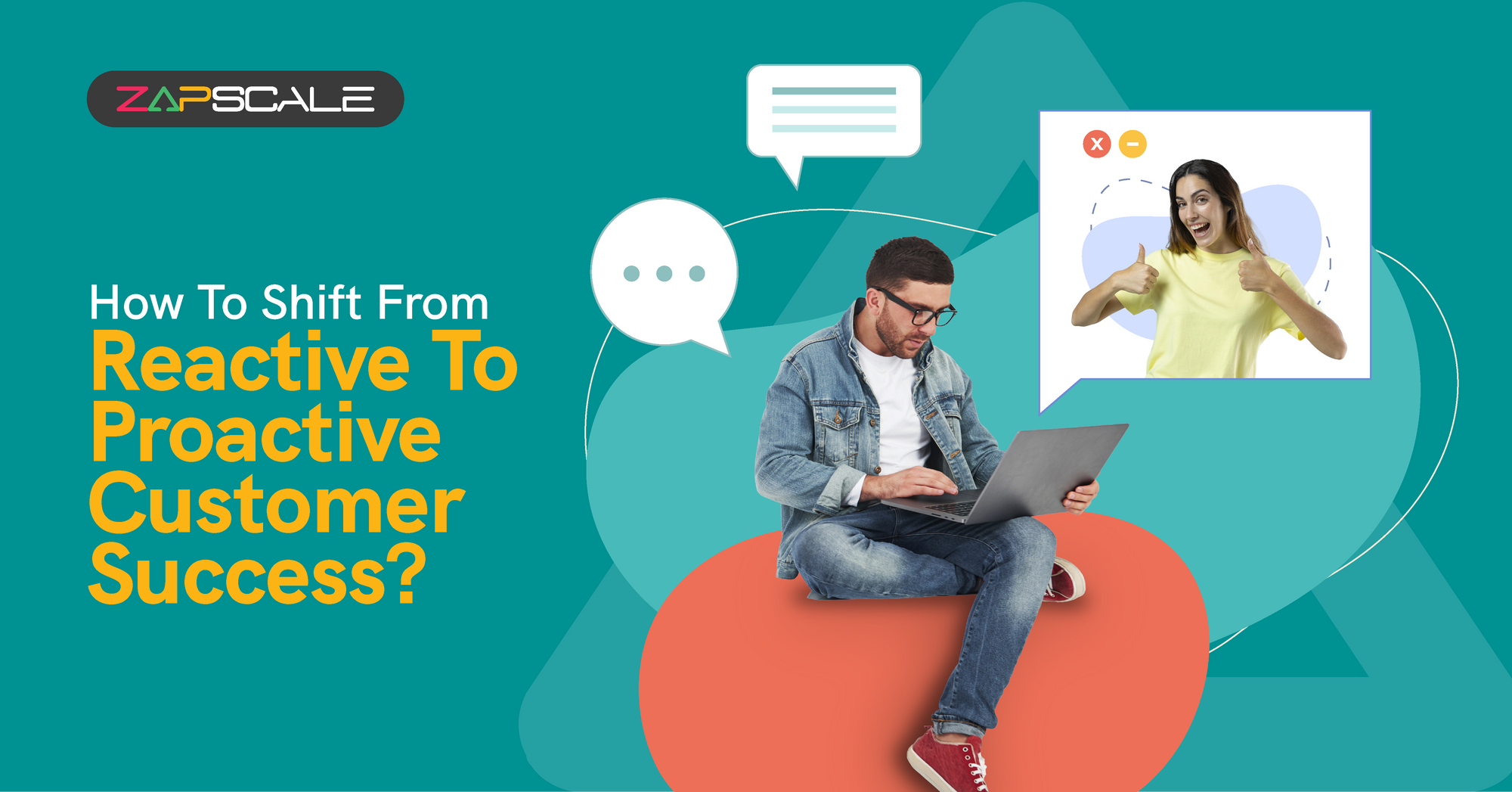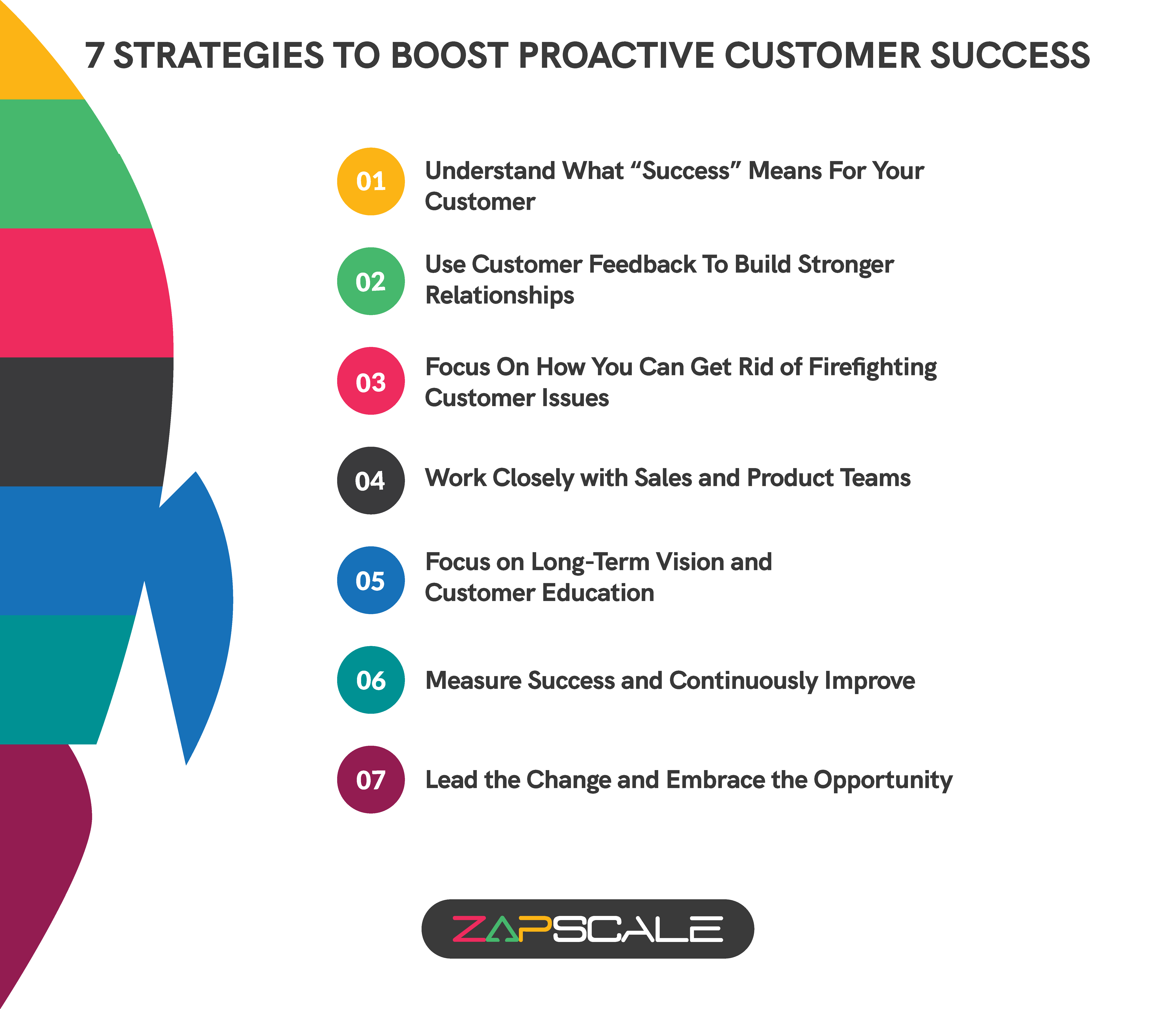CATEGORY > Customer Success Management
How To Transition From Reactive Support to Customer Success

Introduction
Proactive customer success is one of the cornerstones for the success of SaaS companies. However, it is challenging for many businesses to be one step ahead of their customer and know what their headaches and pain points are. It is a slow and gradual process but once you’ve figured out how to proactively resolve customer issues, it rewards you in different forms - better customer retention, satisfaction, and long-term growth.
In this blog, we will talk about the necessary steps you need to take to transition from reactive support to a more proactive customer success strategy. We will discuss how you can guide your customers toward success, increase the chances of renewal (and upsells), and consequently drive positive business growth.
Let’s talk about the practical ways of doing so.
7 Ways To Drive Proactive Customer Success

1. Understand What "Success" Means For Your Customer
If you want to drive a proactive customer success strategy, the first step is to define what success looks like for your customers. It’s imperative to understand how your users are using your product, which features are delivering them the most value, and which best practices are associated with successful outcomes. Identifying these key metrics will help you craft a customer success strategy that actively helps customers achieve their goals.
For example, you can categorize (or segment) your customers by product usage patterns or industry and look at how different segments derive value from your product. What are their pain points? What are the opportunities to streamline their experience or offer more suitable solutions?
Once you have this data, you can document it, create customer personals, and use them to frame your future customer interactions. This forms the foundation for a proactive approach to driving your CS organization which will enable you to anticipate customer needs before they encounter any issues.
2. Use Customer Feedback To Build Stronger Relationships
Strong customer relationships are at the core of any successful CS strategy. You can start by using feedback tools like NPS (Net Promoter Score) or CSAT (Customer Satisfaction Score) to gather qualitative and quantitative data on how your customers perceive your product and your service. These insights are crucial to understand where you can add value and they help you make improvements (or amendments) that your customers actually care about.
Customer feedback can also be used as a conversation starter during usual catch-ups or QBR meetings. Feedback allows you to actively reach out to customers based on their responses.
For example, (those who rate your product highly), you can explore ways to expand their usage or offer new features. For detractors, focus on addressing their pain points and turning them into satisfied users.
Building a feedback loop where customers feel valued and understood not only increases the chances of retention but also strengthens your position as a trusted advisor, which is the ultimate goal of customer success, isn’t it?
3. Focus On How You Can Get Rid Of Firefighting Customer Issues
Customer support is reactive and you spend most of the time addressing issues after they’ve occurred. To transition to Customer Success, you need to shift your mindset toward problem prevention.
You can start by documenting your current reactive support processes and then identifying recurring issues. Then, think of proactive solutions that can prevent them from happening in the first place. This could be as simple as creating targeted interventions such as onboarding guides, how-to videos, or automated check-in emails that provide customers with the right information at the right time.
Another approach is to focus on self-service options. If certain support requests are repetitive, work toward creating in-app solutions or FAQs that customers can use to resolve these issues independently. This not only reduces the workload on your team but also empowers customers to take ownership of the product—an important step in long-term success.
Customer issues are difficult to track, especially when you’re in a SaaS business where there are multiple ways in which you interact with your customers, for example, through your product, feature requests, email communication or in fact through payments. To help you gather all customer data at one place, ZapScale has built a customer success platform that not only gives you deep customer analysis in real-time but also automates your CS workflows and gives you accurate customer churn predictions so you’re always one step ahead and armed with all the necessary information you need to solve your customer issues before they escalate.
4. Work Closely With Sales And Product Teams
Customer success can never operate in isolation. To make the most of your CS efforts, close collaboration with sales and product teams is crucial. From a sales perspective, customer success should begin during the selling process. You must work with your account managers to integrate your best practices and customer success strategies into their conversations with potential clients. You must also ensure that the value being sold is something your team can deliver on and replicate easily.
On the product side, it is important to share the insights you gather through customer feedback and interaction with your product team. Highlight common issues and feature requests, and advocate for improvements or new features that would help your customers succeed. When the product evolution is aligned with the customer's needs, it strengthens both the relationship and the customer’s reliance on your product.
5. Focus On Long-Term Vision And Customer Education
In the early stages of transitioning from reactive support, it's easy to get bogged down by the daily firefighting and support tickets. However, part of the customer success mindset involves educating customers and helping them understand the long-term vision of the product.
Whenever a new feature is launched, use it as an opportunity to re-engage customers. Whether through product demos, webinars, or personalised emails, these touchpoints allow you to build stronger relationships and gather valuable feedback. Show customers how they can integrate the new functionality into their workflows and how it aligns with their long-term objectives.
This continuous process of education and relationship-building ensures that customers see you not just as a support provider but as a strategic partner invested in their success.
6. Measure Success And Continuously Improve
Customer success is like a marathon and not a sprint. It’s important to continuously measure your success metrics, whether that’s renewal rates, upsells, product adoption, or CSAT scores, depending on what you consider to be your North Star metric. These metrics will give you a clear picture of how well your customer success strategy is working and where improvements are needed.
You need to also understand that it is a process, and since nobody is perfect, mistakes will happen. Don’t be afraid to iterate on your processes. CS is about adapting to both customer needs and the evolving landscape of your product. You need to regularly assess your performance, share key insights with leadership, and make data-driven decisions to improve your processes over time.
7. Lead The Change And Embrace The Opportunity
Transitioning from reactive support to customer success isn’t an easy task, and it can often feel overwhelming. However, this change also presents a tremendous opportunity to step up and take ownership of the process. In many cases, Customer success roles emerge organically, and the most successful teams are those that embrace the chaos, carve out their strategy, and position themselves as trusted advisors for their customers.
Conclusion
As you take these steps, keep in mind that CS is not just about increasing renewals or reducing churn—it’s about building lasting relationships and delivering value that drives both customer success and business success. Always remember, start small, refine your approach, remain flexible and your transition from support will be smooth and ultimately lay the foundation for long-term growth.
ABOUT THE AUTHOR
Popular from Customer Success Management
Quality Content,
Straight To Your Inbox!
Subscribe for the latest blogs, podcasts, webinars, and events!

Write a Blog
If you have experience in CS and
a flair for writing, we’d love to
feature you.
Write to us on
hello@zapscale.com




